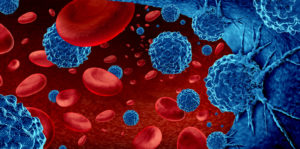
Recently Diagnosed or Relapsed? Stop Looking For a Miracle Cure, and Use Evidence-Based Therapies To Enhance Your Treatment and Prolong Your Remission
Multiple Myeloma an incurable disease, but I have spent the last 25 years in remission using a blend of conventional oncology and evidence-based nutrition, supplementation, and lifestyle therapies from peer-reviewed studies that your oncologist probably hasn't told you about.
Click the orange button to the right to learn more about what you can start doing today.
- You are here:
- Home »
- Blog »
- Multiple Myeloma »
- Extramedullary Myeloma (EMP)- Radiation-induced
Extramedullary Myeloma (EMP)- Radiation-induced

Extramedullary plasmacytoma (EMP) is a rare plasma cell neoplasm characterized by the proliferation of abnormal plasma cells outside the bone marrow.
The average person has less than 5% plasma cells in his/her bone marrow. Multiple myeloma is a blood cancer that occurs when plasma cells in the bone marrow grow out- of-control beyond 5%. It is this out-of-control growth of plasma cells that can cause health problems such as bone damage.
A single plasmacytoma of bone occurs when this out-of-control plasma cell growth occurs in only one spot in the patient’s bone marrow. Multiple myeloma occurs when plasma cells grow out-of-control in multiple spots in a person’s bone marrow.
Overall incidence of EMP is approximately 13%- 7% at diagnosis and 6–20% at relapse [8]. My point is that more EMP occur due to toxic treatment that occur normally.
- The first study linked and excerpted below cites an example of radiation-induced EMP. The radiation therapy was initially used to treat a single plasmacytoma of bone.
- The second paper linked and excerpted below gives a thorough explanation of EMP’s and how challenging they can be to treat.
I guess the moral of the story is that extramedullary myeloma is not well-understood by conventional oncology.
To Learn More About Extramedullary lesions in myeloma see the posts linked below.
- Evidence-based Therapies for Extramedullary Myeloma
- Extramedullary Tumors In Myeloma
- Plasmacytoma- Extramedullary? Suprasellar?
- Bone Imaging Can Make or Break Multiple Myeloma
- Solitary Bone Plasmacytoma
Have you been diagnosed with extramedullary myeloma? Upon your initial diagnosis or upon relapse? Scroll down the page, post a question or a comment and I will reply to you ASAP.
Hang in there,
David Emerson
- MM Survivor
- MM Cancer Coach
- Director PeopleBeatingCancer
Soft Tissue Mass Extramedullary Plasmacytoma Following Radiation Therapy for Solitary Bone Plasmacytoma
“This case report presents the unique scenario of a patient who developed a soft tissue mass ExtraMedullary Plasmacytoma subsequent to receiving radiation therapy for a solitary bone plasmacytoma at a distinct anatomical site. The primary objective of this report is to elucidate the clinical characteristics, diagnostic complexities, and management considerations associated with this uncommon presentation…
Extramedullary plasmacytoma (EMP) is a rare plasma cell neoplasm characterized by the proliferation of abnormal plasma cells outside the bone marrow. It represents approximately 3-5% of all plasma cell tumors and is often found in mucosal sites such as the upper respiratory tract or gastrointestinal tract [1,2]…
EMPs can occur as primary lesions or secondary to underlying plasma cell dyscrasias, such as multiple myeloma (MM) or solitary bone plasmacytoma (SBP) [1]. They are typically diagnosed in the sixth to seventh decade of life, with a slight male predominance [2]. However, soft tissue involvement further complicates the diagnostic process, as the symptoms and imaging findings can mimic other soft tissue tumors.
Radiation therapy is considered the standard treatment for localized EMP, providing excellent local control and favorable outcomes [4]. However, the development of a soft tissue mass EMP following radiation therapy for a solitary bone plasmacytoma adds an additional layer of complexity to the management of plasma cell neoplasms…
The objectives of this case report are to shed light on the rarity of soft tissue involvement in EMP, discuss the diagnostic challenges faced in identifying soft tissue EMP, and provide insights into the appropriate management strategies for this unique clinical presentation…”
Extramedullary disease in multiple myeloma
“EMD remains challenging from a therapeutic and biological perspective. The pathogenetic mechanisms are not completely understood and it is generally associated with high-risk cytogenetics which portends poor outcomes. There is a rising incidence of EMD in the era of novel agents, likely a reflection of longer OS, with no standard treatment approach. Patients benefit from aggressive chemotherapy-based approaches, but the OS and prognosis remains poor…
Overall incidence of EMM is 13%:7% at diagnosis and 6–20% at relapse [8]. 85% of these are bone-associated and the median age for patients is higher as compared to patients with bone-independent EMD (71 vs 60.5 years) [2]. There has been an overall increase in the incidence of EMM from 6.5% in 2005 to 23.7% in 2014 [9]…
Extramedullary tumor masses in CNS most frequently arise from bone lesions in the cranial vault, skull base, nose, or paranasal sinuses, whereas primary dural (pachy-meningeal) involvement is rare. The OS with osteodural involvement (25 months) is three times more than leptomeningeal involvement (6 months) [35]. For CNS EMD, a combination of CNS directed treatment including RT and IT chemotherapy and systemic therapy including novel agents which can cross blood brain barrier (BBB) has shown activity [35, 36]…
The preferred next step in patients who respond to induction therapy is transplant. However, the benefit of ASCT in patients with EMD appears to be more limited…
Relapse after transplant Patients with MM with EMD at diagnosis or during the disease course have a higher risk of EMD at relapse following HDT…”


